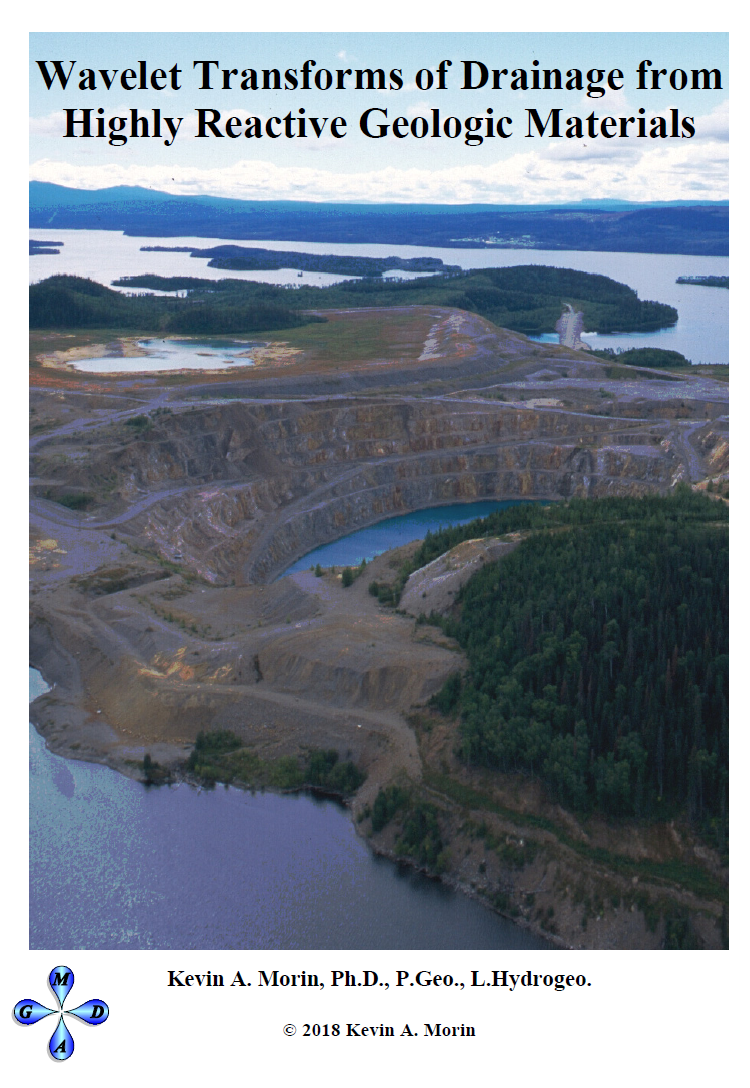
Home ⋅ Book: Environmental Geochemistry ⋅ Book: An Introduction ⋅ Book: EFA ⋅ Book: Spectral ⋅ MDAG Papers ⋅ MDAG IKD Database ⋅ MDAG Grain 3.0 ⋅ Minewall 3

This free book released in 2018 entitled, "Wavelet Transforms of Drainage from Highly Reactive Geologic Materials" (ISBN 978-0-9952149-3-4),
is available for download here at MDAG.com (see the download link below).
It is the sequel to Spectral Analysis of Drainage from Highly Reactive Geologic Materials.
To understand better minesite drainage and other drainages from highly reactive geologic materials, this book returns to the
late 1940's.
At that time, work on "abrasion pH" showed that each mineral, when placed in contact with
stagnant water, could generate a unique pH and, by extension,
unique aqueous concentrations of elements. Abrasion pH was sometimes called "equilibrium pH".
In the early 1980's, full-scale field studies at minesites and related computer modelling showed that equilibrium pH was the result of a complex
interplay among primary minerals, secondary minerals, and mobile aqueous chemistry in
flowing water. For acidic and alkaline drainages, this interplay created a step-like,
chromatographic change in pH and chemistry along flowpaths and through time. Site-specific mineral solubilities and other factors meant that each site
could generate unique chromatographic profiles in time and space, even if the same minerals were present.
In the 2000's, aqueous concentrations in drainages from undisturbed and agricultural watersheds, measured at high frequency, were found to be highly
dynamic and complex. They even varied significantly from hour to hour. Moreover, these variations followed complex mathematical patterns called "fractals".
This included "1-over-f" spectral slopes which is the topic of much research in many fields of the sciences and arts.
In effect, the periodic measurement of an aqueous concentration in drainage, at one moment in time, was found to be
only part of the story. Just as
important was how concentrations varied over hours, days, months, and years.
In 2016, least-squares spectral analysis revealed that drainages from highly reactive geologic materials at minesites, when monitored at high frequency
and for extended periods of time, showed fractal patterns in their time series and spectral slopes. This included several
1-over-f slopes, as well
as random ("white") and random-walk ("red") slopes.
For some sites, the presence of an upstream water-retention structure, like a pond or low-permeability stratum, could alter or disrupt the spectral slopes
in distinctive ways. This highlighted the importance of water retention on variations in downstream concentrations, even when the structure such as a buried
pond-like depression or subsurface stratum was not documented.
This book synthesizes all this previous work into a conceptual model with a physical analogue
based on coiled springs. Then wavelet transforms are used with full-scale case studies
to learn more about the variations in concentrations, which spectral analysis
alone cannot provide. These case studies include
drainages from waste rock, tailings, and open pits.
Topics discussed in this book include:
- evolution of aqueous chemistry and flow through operation and closure;
- similarities of oscillations in pH and many other aqueous elements, even when time series and spectral analyses show significant differences;
- small differences in oscillations of aqueous iron, pointing to additional processes such as redox reactions increasing its dynamic geochemical tension;
- short-term and long-term effects of a surficial low-permeability soil cover;
- changes in "dynamic geochemical tension" without geochemical chaos during major changes in pH;
- separation of temporal trends in aqueous concentrations and their oscillations at short wavelengths;
- implications of small changes in near-neutral pH; and,
- common wavelengths at which aqueous concentrations typically oscillate strongly in drainages.
Important Publications Relevant to This Book
Morin, K.A. 2019. Application of Spectral Analysis and Wavelet
Transforms to Full-Scale Dynamic Drainages at Minesites.
Springer Nature (SN) Applied Sciences 1:1058, published online August 2019.
DOI: 10.1007/s42452-019-1102-3. Online version
at Springer.com at
https://link.springer.com/epdf/10.1007/s42452-019-1102-3
Morin, K.A. 2020. MDAG-com Case Study 63 - Planetary and large-scale processes affecting minesite-drainage flows and chemistries.
MDAG Internet Case Study #63,
www.mdag.com/case_studies/cs63.html
This book is free.
Please click on "Get access code", enter the case-sensitive code, click on "Validate code",
and you will be redirected to the book in PDF format (~65 MB in size).
See also the book: Spectral Analysis of Drainage from Highly Reactive Geologic Materials
Home ⋅ Book: Environmental Geochemistry ⋅ Book: An Introduction ⋅ Book: EFA ⋅ Book: Spectral ⋅ MDAG Papers ⋅ MDAG IKD Database ⋅ MDAG Grain 3.0 ⋅ Minewall 3
Created by K.Morin